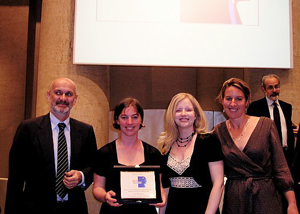Disclaimer: This material is being kept online for historical purposes. Though accurate at the time of publication, it is no longer being updated. The page may contain broken links or outdated information, and parts may not function in current web browsers. Visit chandra.si.edu for current information.
A Journey of 1,000 Miles (or more) Begins With A Single Chandra Podcast
by Megan Watzke June 28, 2007 ::
From women's restrooms to Roman baths. That's the path that the Chandra podcasts have traveled so far. Let's take this odd journey in reverse and begin in Rome.
On May 11, 2007, the Chandra podcasts received the Pirelli International award for physics. The Pirelli award, established in 1996, is the world's first Internet multimedia award aimed at the diffusion of scientific and technological culture worldwide. Members of the Chandra group accepted in a ceremony at the Temple of Hadrian in Rome, Italy, with other winners, members of the Italian government, and media in attendance.
Such a dignified event must have been the culmination of an equally cultured start? Well, not exactly.
When the Chandra Education and Public Outreach (EPO) group first started work on its podcast productions early in 2006, an interesting problem arose. Where can one go where it is truly quiet? One place turned out to be next to the women's bathroom in the basement of the Chandra X-ray Center offices.
Why, one might ask, would the EPO group need to lurk outside rest rooms? The answer involves the need to interview scientists who are featured in the Chandra podcasts. The hum of computers and the rattling of the heating system are so common that most people don't even notice them. However, sensitive recording equipment does pick up such unwanted background noise. Therefore, for the inaugural Chandra podcast, the unorthodox recording site was found (and used).
Fortunately, since that first podcast, other quiet -- and more respectable -- spaces at the Chandra X-ray Center have been identified. However, its unglamorous start does illustrate the wide range of problems that a nascent medium, such as podcasting, presents.
If you are unfamiliar with podcasts, it might be worth finding a teenager or a relatively technically savvy adult to ask. In short, podcasts are multimedia files that are broadcast over the Internet -- either on a computer or a mobile playback device like an iPod or an mp3 player.
Podcasting is a new and fast-growing way for people and organizations to share information. According to Wikipedia, the concept of podcasting was first reported in 2000 and its technical components were available in 2001. By 2003, podcasts began showing up on well-known websites. In 2005, "podcasting" was declared the word of the year by the New Oxford Dictionary.
As a burgeoning medium, podcasts have very few, if any, rules or standards. Instead, every organization's podcast is different in content, style and length. In late 2005, when just a handful of space science podcasts existed, the EPO group decided to start producing Chandra podcasts. The decision was made to keep the Chandra podcasts relatively short, typically three to five minutes, with a goal of one new podcast per month. After covering the very basics of the satellite and X-ray astronomy in the first few episodes, the podcasts have gone on to explore topical areas that Chandra studies such as black holes, galaxy clusters, and supernovas.
The first step to create a Chandra podcast is to come up with a concept. After a rough script is written, the EPO group enlists the help of scientists who specializes in that area to both lend their voice to the audio and their expertise in polishing the content. While it is a young medium, most podcast producers report that users are more attentive if there is more than one voice. Therefore, the Chandra podcasts' format is one of a narrator and scientist who alternate speaking.
While the audio portion of the podcast is a crucial component, it is not the only one. That's because the Chandra EPO group elected to make so-called "vodcasts", or video podcasts, from the start. Vodcasts contain images and graphics as well as the traditional audio most podcasts feature. In order to be accessible to the widest audience, however, a user has the option of selecting the video and audio version of the Chandra podcast, the audio only, or just the transcript of the program.
The video for the vodcasts comes from a compilation of Chandra images, illustrations, and animations that are relevant to the topic being discussed. It takes careful editing to match the content and timing of the audio and video. After several iterations among EPO group members and NASA officials, including a final check from the Chandra press scientist, the podcast is made into several different formats. In addition to the web, the podcasts are formatted into broadcast-quality segments for airing on NASA-TV and DVD-quality for Chandra products.
Chandra's podcasts are available on its main website (chandra.harvard.edu), but that's not the only place to find them. Apple's popular iTunes Music Store acts as one major distribution point for podcasts, and Chandra's can usually be found at #25-30 in the Natural Sciences category. To cast an even wider net, Chandra podcasts are linked from the NASA and Smithsonian web portals, as well as podcast portals such as PodcastAlley, PodcastPickle and LearnOutLoud.com, among others. Chandra podcasts are also advertised via news aggregators or "podcatchers" such as Feedburner via the RSS feed. Recently, Chandra podcasts were also added to YouTube. The Chandra podcasts have been used in pleasantly surprising ways. For example, teachers have reported using them in classrooms as introductions to astronomical topics.
It's said every journey begins with a single step. The first step for the Chandra podcasts was down in the basement, but they have since traveled the globe. As the EPO group strives to improve and expand the podcasts, the hope is the public enjoys them as another way to help understand our Universe a little bit better.
Disclaimer: This material is being kept online for historical purposes. Though accurate at the time of publication, it is no longer being updated. The page may contain broken links or outdated information, and parts may not function in current web browsers. Visit chandra.si.edu for current information.










